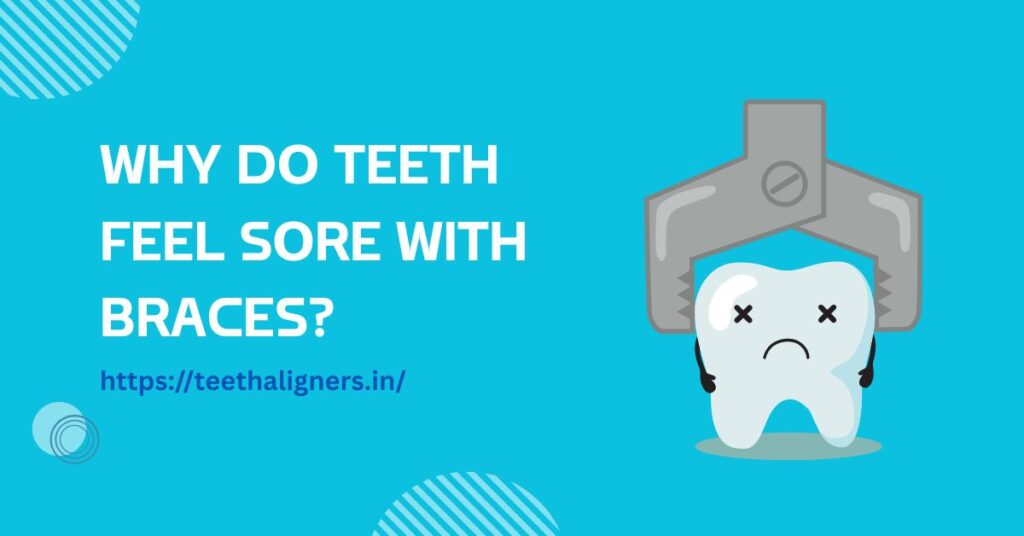Imagine the excitement of finally starting orthodontic treatment and looking forward to a straighter smile. Along with the joy, many patients soon notice an uncomfortable reality,their teeth feel sore.
This common question often arises: why do teeth feel sore with braces? The answer lies in the way teeth, gums, and supporting bone respond to gentle but steady pressure.
When explained simply, it becomes clear that soreness is not something to fear but a natural part of the journey.
By understanding the biological and mechanical reasons, patients can feel more confident about the process and know how to handle the temporary discomfort.
Table of Contents
ToggleWhat Happens When You First Get Braces
The process begins when an orthodontist carefully attaches brackets to the surface of each tooth and threads a wire through them. The wire is secured with tiny elastic ties, creating a system that guides teeth into better alignment.
From the very first moment the wire is in place, it begins applying light and steady pressure. Even though the force is minimal, your teeth and the tissues holding them notice the change right away. This is why soreness often begins within hours of leaving the dental chair.
The teeth are not used to being pushed, and the ligaments around them start stretching and compressing. For many, this leads to a dull ache that lasts for a few days. Fortunately, this discomfort is temporary. As your mouth adjusts, the soreness begins to fade.
During this stage, it helps to eat softer foods and take things slow, giving your body time to adapt to the new appliance. Some patients who prefer a less noticeable option may choose discreet teeth aligners, which also work by applying gentle pressure, though without the brackets and wires.
Why Teeth Feel Sore After Adjustments
Orthodontic treatment does not end after the first appointment. To keep teeth moving in the right direction, orthodontists schedule follow-up visits.
At these visits, the wires may be tightened or replaced to apply fresh pressure. Each adjustment restarts the process of movement, which means the soreness often returns.
Patients describe this discomfort as similar to the initial stage, but usually it fades more quickly since the body has already adapted to the idea of movement.
This cycle of pressure and relief is completely normal. It may feel frustrating at times, but it is evidence that the treatment is working, guiding teeth step by step into better alignment.
The Biology Behind Soreness
How Teeth Move in the Jaw
Teeth are not cemented directly into bone. Instead, each tooth is held in place by a soft but strong tissue called the periodontal ligament. This ligament acts like a cushion, giving teeth a slight ability to move without damaging the bone.
When the orthodontic wire applies pressure, one side of the ligament compresses while the opposite side stretches. This tiny but important change signals the body to start the remodeling process that makes tooth movement possible.
Role of Ligaments and Bone
The soreness patients feel is directly connected to this remodeling. On the side where pressure is applied, bone cells begin to break down, creating space for the tooth to shift. On the opposite side, new bone forms to secure the tooth in its new position.
This balance of breaking down and rebuilding is slow and steady, ensuring that teeth move safely. The stretching of ligaments and the activity in the bone are what create the sensation of soreness.
Why Some People Feel More Pain Than Others
Not every patient experiences the same level of soreness. Differences in pain threshold explain why some people feel only mild discomfort while others find the process more difficult.
Age also plays a role. Younger patients, such as teenagers, often adapt faster because their bones are softer and tissues are more flexible.
Adults, with denser bone structures, may notice stronger soreness that takes slightly longer to subside. Genetics, overall health, and even stress levels can influence how soreness is perceived.
Everyday Factors That Can Increase Soreness
While the natural biological process causes mild discomfort, daily habits can make the soreness worse. Eating hard or crunchy foods, such as apples, chips, or nuts, forces the sensitive teeth to handle extra pressure.
Chewing gum or biting nails can strain both the brackets and the surrounding tissues. Even stress can add to the soreness, especially if it leads to teeth grinding at night.
Avoiding these habits makes a big difference. Being mindful about food choices and oral behaviors helps keep the soreness at a tolerable level while allowing the orthodontic treatment to progress smoothly.
How Long Does the Soreness Last?
For most patients, soreness does not last long. After getting braces or after an adjustment, the discomfort usually peaks within the first 24 to 48 hours. By the third or fourth day, the soreness often begins to fade noticeably.
Within a week, most patients can eat and speak without much trouble.However, there are rare cases where soreness lingers longer than expected.
Sometimes this can be due to a wire that is slightly out of place, a bracket causing irritation, or extra sensitivity in certain teeth. In such situations, it is wise to consult the orthodontist rather than waiting for the pain to disappear on its own.
Ways to Relieve Soreness
Soft Foods That Help
During the first few days, sticking to soft foods makes eating easier and less painful. Yogurt, smoothies, mashed potatoes, soups, rice, and well-cooked vegetables provide nutrition without forcing teeth to bite down hard.
Many patients in South Delhi also find comfort in soft local dishes that are both tasty and gentle on the teeth. Choosing these foods allows your mouth to recover more comfortably.
Cold Compress and Rinses
Cold therapy is another simple yet effective way to ease discomfort. Holding a cold compress against the outside of your cheek for ten to fifteen minutes can reduce soreness.
Warm saltwater rinses are also helpful, soothing irritated gums and promoting healing. These remedies are natural, safe, and can be repeated throughout the day when needed.
Over-the-Counter Pain Relief
If the soreness feels overwhelming, mild pain relief can help. Medications commonly available at pharmacies are effective when taken as directed. It is important, however, not to overuse them.
The goal is to take the edge off the discomfort, not to eliminate all sensation. Feeling a little pressure is normal and confirms that your treatment is progressing. Always check with your dentist before using any medication regularly.

When Soreness Is a Warning Sign
Although soreness is a natural part of treatment, there are times when discomfort signals a problem. If you experience sharp pain rather than a dull ache, it may mean that something is out of place.
A wire poking into the cheek, a broken bracket, or gum swelling can all cause unusual pain that should not be ignored.In such cases, reaching out to a dentist quickly is important.
Residents of South Delhi are fortunate to have access to many qualified dental professionals who can provide fast relief. Prompt attention prevents small issues from turning into bigger problems and keeps the treatment on track.
Emotional Side of Braces Soreness
The soreness of braces does not affect only the mouth,it also influences emotions. Eating can feel challenging, speaking may sound different, and some patients feel less confident about smiling in the early stages. These emotional hurdles are completely normal but can still be frustrating.
This is where encouragement from family and friends makes a big difference. A positive environment helps patients focus on the long-term benefits rather than the short-term discomfort.
Clinics such as Teeth Aligners in India also remind patients that soreness is part of a bigger journey toward a healthy and attractive smile. Knowing that professionals are available to provide guidance and reassurance makes the process easier to handle.
Final Tips for Managing Braces Journey
Staying consistent with dental visits is one of the best ways to manage soreness and progress smoothly. Regular check-ups allow the orthodontist to monitor movement and make adjustments safely.
Good oral hygiene is equally important. Clean teeth and gums are less likely to develop irritation, making the treatment more comfortable overall.Patience plays a vital role too.
Orthodontic treatment is a gradual process, and every bit of soreness is a sign that teeth are shifting into better positions. Reminding yourself of the outcome,a straighter, healthier smile,can help you stay motivated through the occasional discomfort.
Conclusion
Teeth feel sore with braces because the body is responding to gentle, continuous pressure. The periodontal ligaments stretch and compress, bone cells remodel, and teeth shift step by step into new positions.
While the soreness may feel strong at times, it is temporary and manageable with soft foods, simple home remedies, and professional care when needed. Every ache is part of the process that leads to lasting benefits.
By staying patient, practicing good habits, and seeking guidance when necessary, patients can handle the soreness with confidence and look forward to a healthy, well-aligned smile.

